Contents
Everything you need to know about Asian and Australian Standards and Specifications for Cements
[wpecpp name=”package” price=”75″ align=”center”]
by Akio Tsudo* and Musarrat Ullah Khan Afridi**
Steady industrial progress of several of the Asian countries coupled with an ever-increasing Asian market size (over half of the world’s population resides in Asia) has resulted in nearly 60% of the world’s cement production originating in Asia. Total Asian cement production stands close to 900 million metric tons/year (Figure 9.7.1). Although less advanced than most European and North American counterparts, the Asian cement industry has done remarkably well in producing a variety of cements while maintaining their quality based on standardized specifications. Most Asian coun-tries follow the protocol of American Society for Testing and Materials – ASTM and British Standards (BS), while others have adopted local standards to specify cement performance.
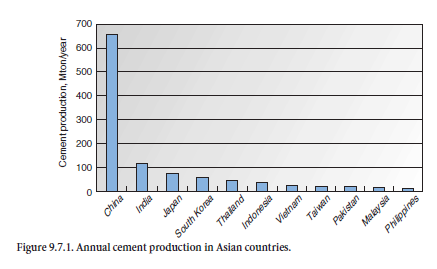
PRODUCTION OF PORTLAND CEMENT IN ASIAN COUNTRIES
Listed below are the major cement-producing countries in Asia that each have accounted for over 10 million metric tons cement a year. They include China, India, Japan, South Korea, Thailand, Indonesia, Taiwan, Philippines, Vietnam, Malaysia, and Pakistan. Table 9.7.1 (also, see Figure 9.7.1) shows the breakdown of their production levels. Also shown is a comparison with the other major cement producing regions of the world, i.e., Europe, Americas, and the Middle East.
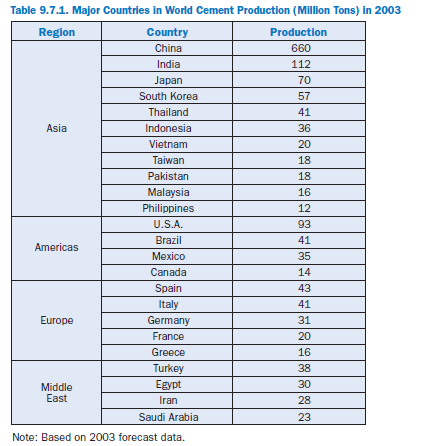
It must be noted that according to the 2003 data, China is by far the largest single cement produc-ing country in the world, followed by India, the United States, and Japan.
The south Asian countries, include Bangladesh, Sri Lanka, Nepal, and Bhutan. Their combined annual cement production is close to 3 million tons.
STANDARD SPECIFICATIONS OF CEMENTS FOR EACH COUNTRY
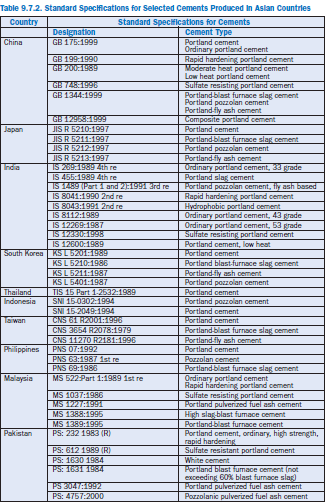
Each of the major cement producing countries in Asia has adopted their own designations for the types of cement produced. A summary of selected designations and the corresponding types of cements from each country are given in Table 9.7.2.
It can be seen from Table 9.7.2 that the range of cements produced in Asia varies from ordinary portland to a variety of specialty cements such as rapid-hardening, sulfate-resistant, low-heat, moderate-heat, and several blended cements prepared by incorporating slag, fly ash, and other types of manufactured additions (i.e., calcined clay) as well as naturally available pozzolans.
Approximate Compositions
Approximate compositions of most common cement types mentioned above are shown in Table 9.7.3. Detailed compositional, product, and performance based specifications on cements from each Asian country are presented in a later section of this chapter.
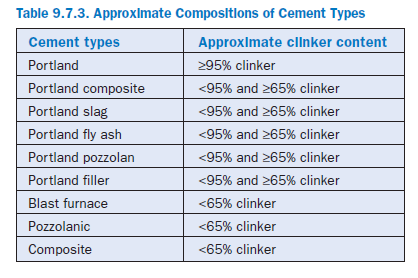
Procedure for Specimen Preparation Physical Performance
Procedures for preparing specimens for testing cement strength in each country have different requirements for specimen size, standard sand, and cement to sand ratios. Table 9.7.4 shows speci-fication requirements for preparing specimens for strength as well as other physical testing for various Asian countries. As can be seen, several countries in Asia tend to follow procedures similar to those specified by the American Society for Testing and Materials (ASTM), while some follow the British Standards (BS), and others the International Standards Organization (ISO).
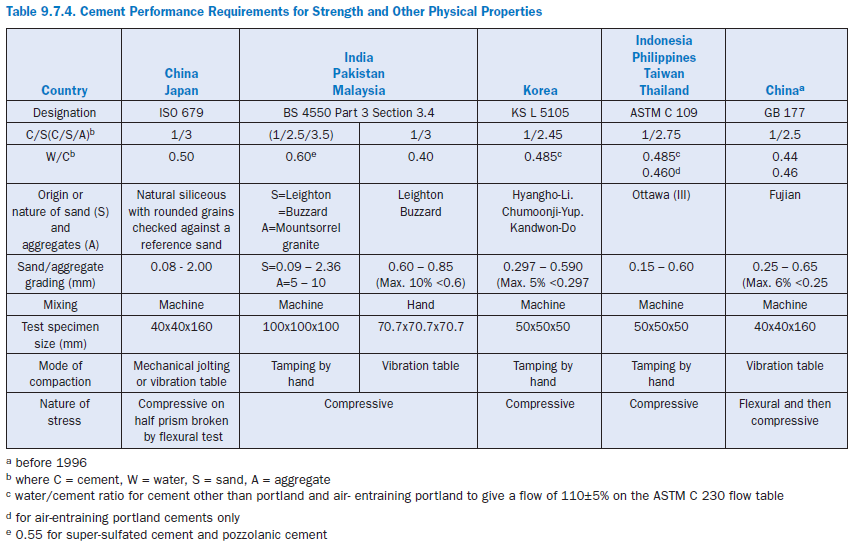
FEATURES OF CEMENT QUALITY STANDARDS IN ASIAN COUNTRIES
Each Asian country has its own criterion for adopting cement standards. The following section discusses some of the features for cement quality standards based on physical and chemical requirements.
China
Physical requirements. China recently established GB/T 17671, a new method of strength test-ing for cement that is consistent with ISO 679. In addition to modifying the testing method, the standards for compressive strength – GB 175, GB 1344, and GB 12958 – were also revised.
The main revisions in the method of strength test for cement are as follows:
• Particle size range of standard sand changed from 0.25–0.65 mm to 0.08–2.00 mm.
• Water/cement ratio changed from 0.44 to 0.50.
• Sand/cement ratio changed from 2.50 to 3.00.
The main revisions for the quality standards are as follows:
• Requirements for the strength test at 7 days were abolished.
• Early strength is to be reported only at 3 days.
Chemical requirements. Beside chemical requirements of GB 175, portland cement and ordi-nary portland cement have no specification limit for chloride, and the limit for Na2O equivalent is defined at 0.60%. The composition of cement type PB specifies that total clinker plus calcium sulfate shall be 85% – 94%; the maximum level of slag, pozzolan, and fly ash shall be ≤15%; and limestone ≤10%.
Japan
Japan combined JIS R 5201 (Physical Testing Methods for Cement) with ISO 679 (Methods for Testing Cements: Determination of Strength) and ISO 9597 (Methods of Testing Cements: Determination of Setting Time and Soundness) in 1997. JIS R 5202 (Methods of Chemical Analysis of Portland Cement) was revised to be consistent with ISO 680 (Cement Test Methods: Chemical Analysis) in 1999.
The value of compressive strength specified in the following quality standards will be revised by the changes of the standard sand, mix proportion of mortar, molding method of specimen and the method of surface finishing in accordance with ISO 679.
• JIS R 5210 Portland cement
• JIS R 5211 Portland blast-furnace slag cement
• JIS R 5212 Portland pozzolan cement
• JIS R 5213 Portland fly ash cement
Japan had registered as a member of ISO/TC74 in August 1998 and organized J/TC 74. J/TC 74 is studying the revision of standards to be combined with EN 197 Part 1 (Cement-Composition Specifications and Conformity Criteria: Common Cements) and EN 197 Part 2 (Conformity Evaluation).
India
Chemical requirements. The composition of portland cement (Ordinary Portland, Rapid Hardening Portland, Sulfate Resisting Portland) shall contain no more than 2% or 4% insoluble residue for cements where clinker and calcium sulfate total 100% (without supplementary cement-ing materials). The Na2O equivalent is limited to 0.6% when cement is used with aggregate which may be deleteriously reactive. The maximum chloride content is 0.05% for prestressed and long-span reinforced structures.
South Korea
Chemical and physical requirements. The specification KS L 5201 for Portland cement is the equivalent of ASTM C 150 Standard Specification for Portland Cement. The following five Korean cement types are covered in the specifications:
P1: Ordinary portland
P2: Moderate heat portland P3: High early strength portland P4: Low heat portland
P5: Sulfate resistant portland
The composition of portland cement is specified such that the sum of the clinker and calcium sulfate contents are ≥95%. Admixtures like slag, pozzolan, and fly ash shall be ≤5% and shall not include limestone. Chlorine and Na2O equivalent limits are not specified in the chemical requirements.
Types A, B, and C are defined as blended cements consisting of 5%-10%, 10%-20%, and 20%-30%mineral additives respectively in accordance with KS L 5211 (Portland Fly Ash Cement) and KS L 5401 (Portland Pozzolan Cement). Two cement types (special grade and grade 1) define mix proportions consisting of 25%-65% mineral additives in accordance with KS L 5210 Portland Blast Furnace Slag Cement.
Thailand
Chemical and physical requirements. The TIS 15 Portland Cement specification is an equivalent to the ASTM C 150 Standard Specification for Portland cement. The following five cement types are defined by the specifications; these quality standards do not include any supple-mentary cementing materials:
I: Ordinary portland
II: Moderate heat of hydration portland and moderate sulfate resistance portland III: High early strength portland
IV: Low heat of hydration portland
V: High sulfate resistance portland
Specifications for setting, soundness, fineness, and chemical requirements are similar to those of the ASTM C 150; however values specified for compressive strength are different.
Indonesia
Chemical and physical requirements. The specification SNI 15-2049 for Portland Cement is also equivalent to the ASTM C 150 Standard Specifications for Portland Cement. The following five cement types are defined by these specifications. These quality standards do not include any supple-mentary cementing materials.
I: Portland
II: Portland with moderate heat of hydration or sulfate resistance III: Portland with high early strength
IV: Portland with low heat of hydration
V: Portland with high sulfate resistance
The quality standards are similar to ASTM C 150, however loss on ignition (L.O.I.) of Type I is ≤5.0% as compared with ≤3.0% in the ASTM C 150. Insoluble residue of ASTM C 150 is ≤0.75%, whereas, for Type I Indonesia cement the insoluble residue is ≤3.0%, and for the other cement types it is ≤1.5%.
Taiwan
Chemical and physical requirements. The specification CNS 61 R2001 for Portland Cement is similar to the ASTM C 150 Standard Specifications for Portland cement. It classifies the following types.
I: Portland
IA: Air-entraining portland
II: Moderate sulfate resisting portland
IIA: Moderate sulfate resisting air-entraining portland
II: Moderate heat of hydration portland
IIA: Moderate heat of hydration air-entraining portland
III: High early strength portland
IIIA: High early strength air-entraining portland
IV: Low heat of hydration portland
V: High sulfate resisting portland
The main difference from ASTM C 150 is that the total clinker and calcium sulfate content of the ASTM C 150 Type I Portland cement is 100%, whereas for the Taiwan Type I cement it is ≥95%, and for slag and fly ash it is ≤5.0% of the supplementary cementing materials. Because of this specification, the insoluble chemical residue requirement is ≤4.30% as compared to ASTM C 150 specified ≤0.75%.
CNS 11270 R2181 Portland fly ash cement specifies Types A, B, and C, and the mix proportion of each supplementary cementing material is 5%-10%, 10%-20%, and 20%-30% respectively.
CNS 3654 R2078 Portland blast furnace cement also specifies 2 types with mix proportions of 25%-65% SCMs.
Philippines
Chemical and physical requirements. The PNS 07 Portland Cement Specification is also similar to ASTM C 150. The following five cement types adhere to these specifications. These qual-ity standards do not include any admixtures.
I: Portland
II: Moderate sulfate resistance portland or moderate heat of hydration portland
III: High early strength portland
IV: Low heat of hydration portland
V: High sulfate resistance portland
P: Ordinary portland
HSP: High strength portland
RHP: Rapid hardening portland
SR-P (A): Sulfate resistant portland
SR-P (B): High strength sulfate resistant portland
WC: White cement
PBLF: Blast furnace
PPFA: Portland pulverized fuel ash
POZPFA: Pozzolanic pulverized fuel ash
Chemical and physical requirements. The specification requires that Blast Furnace Cement shall contain at least 35% blast furnace slag and a maximum of 65% clinker. The composition of all cement, i.e., Ordinary Portland, Rapid Hardening Portland, Sulfate Resisting Portland, and Blast Furnace, shall have no more than 3% L.O.I., and between 1.5% to 2.0% insoluble residue. The maximum MgO and SO3 contents allowed for Blast Furnace Slag cement are 7% and 1.5% respec-tively. The minimum Blaine fineness for all cements is between 225 and 250, except for the Rapid Hardening Cement, for which the minimum Blaine is 325. The minimum 3-day strength for Rapid Hardening Cement is 29 MPa.
STANDARD SPECIFICATIONS FOR CEMENTS IN ASIAN COUNTRIES
Summarized information of standard specifications on selected cements produced in the major Asian countries is presented in Table 9.7.5. Included in the table are the following selected criteria for each cement:
• Description (Types and symbols)
• Composition (Clinker + calcium sulfate, slag, fly ash, pozzolan, etc.)
• Performance requirement (Vicat initial and final setting, autoclave expansion)
• Fineness (Blaine m2/kg)
• Chemical requirements (L.O.I., insoluble residue, SO3, MgO, C3A)
• Physical requirements (Compressive strength: 3-day, 7-day, 28-day)
The information in Table 9.7.5 is selective and readers are encouraged to obtain current and complete versions of the specifications.
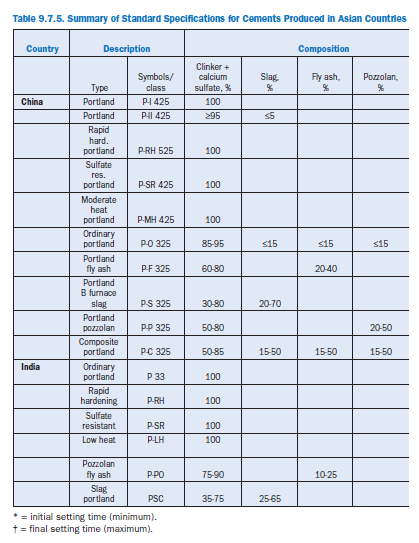
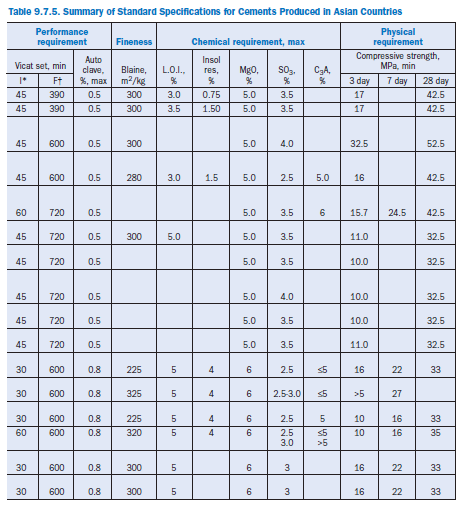
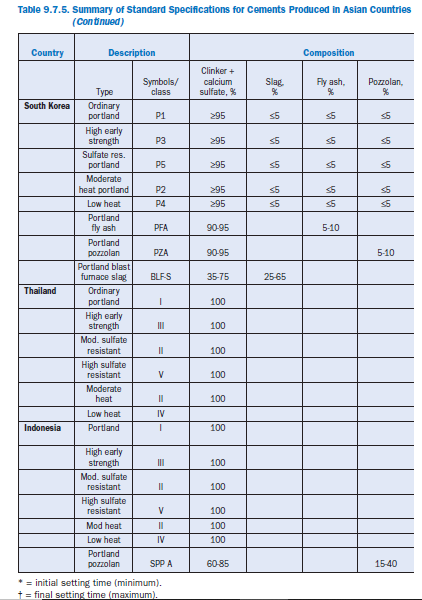
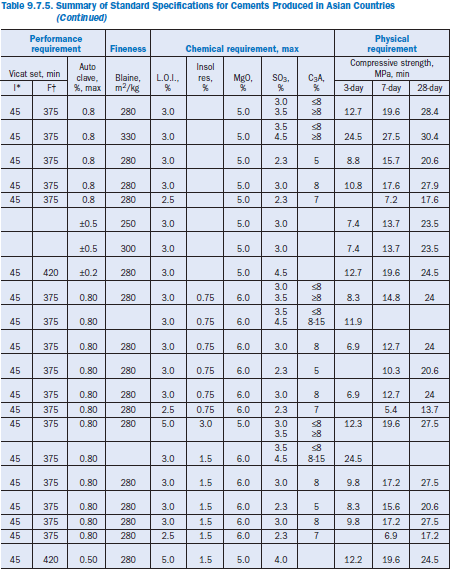
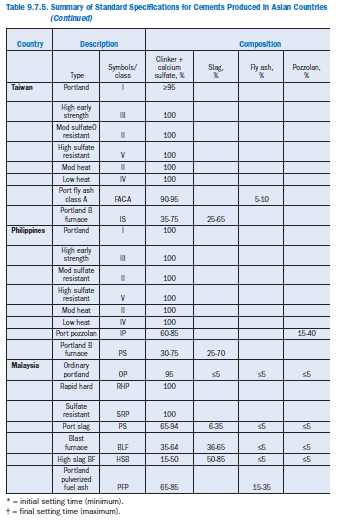
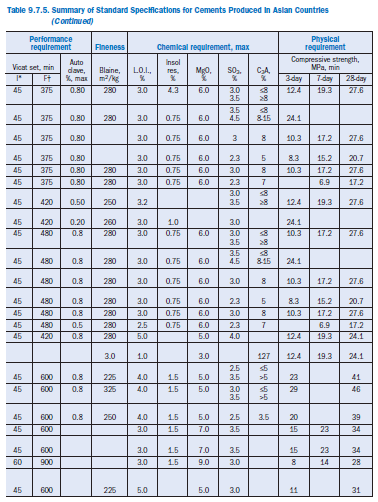
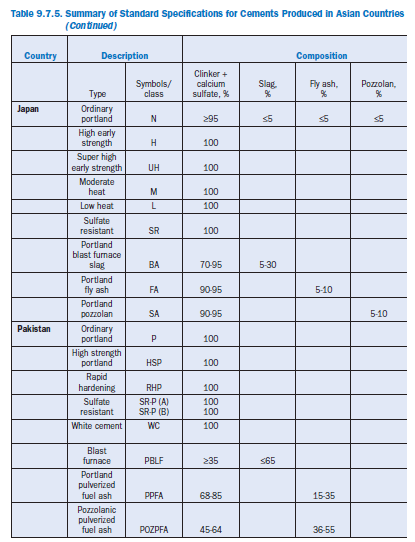
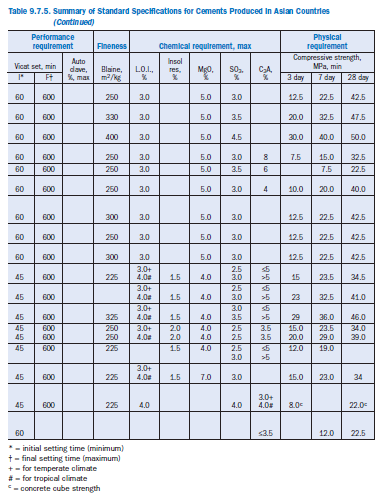
CEMENT SPECIFICATIONS IN AUSTRALIA
Annual production of cement in Australia amounts to 8 million tons. The types of cements produced in Australia include portland cement, blended cements, and special purpose cements. The quality of these cements is maintained by compliance with the national standards and specifications as covered by he Australian Standard AS 3972 – 1997 on “Portland and Blended Cements.” These standards were updated in 1997 and superseded the previous standards AS 3971 – 1991. Several important amendments were made in this revision. Firstly, cements were defined in terms of their performance characteristics and non-essential prescriptive limits were eliminated. By definitions, a general purpose cement may be a portland cement (Type GP) or a blended cement (Type GB), and special purpose cements may be portland or blended cements with restrictions placed on their composition. Secondly, port-land cement is permitted to contain up to 5% mineral additions including ground limestone containing >80% CaCO3. Thirdly, the properties of both portland and blended cement are divided into two categories, 1) those to which limits are applied, and 2) those for which limits are not spec-ified but their results must be produced upon the request of the consumer.
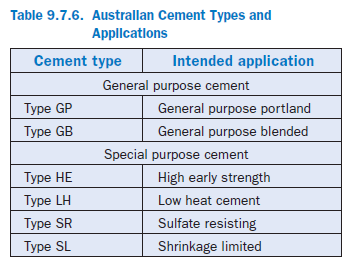
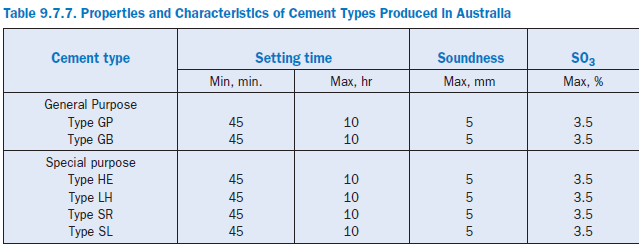
Portland cement clinker must not contain more than 4.5% MgO. By definition, blended cement contains portland cement and one or both of 5% fly ash or blast furnace slag, or both. Introduction of Amendments 2 and 3 allowed the inclusion of sulfate resisting (Type SR) and shrinkage limited (Type SL) cements; Amendments 2 also permitted the use of up to 10% silica fume in the blended cements. Identification of cement types and their intended applications are given in Table 9.7.6, while their performance requirements per AS 3972 – 1997 are set out in Table 9.7.7. Calcium sulfate (typically in the form of gypsum) added during intergrinding with clinker, is required to contain no less than 30% SO3 content.
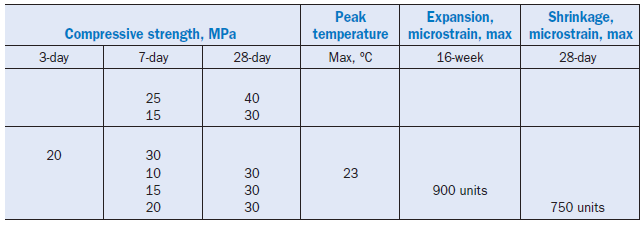
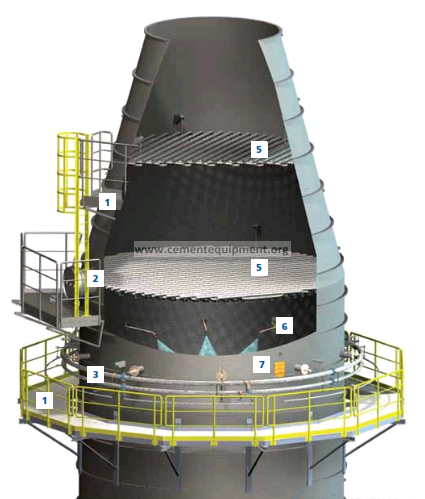
Thank you for providing such a comprehensive overview of the Asian and Australian standards for cements! It’s fascinating to see how these specifications impact both the quality and performance of cement in various applications. Your detailed breakdown of the differences between these standards highlights the importance of compliance in achieving durable structures.
As a general contractor, I’ve often worked with stucco and its reliance on quality cement for optimal performance. In your experience, how do the differences in standards influence the choice of cement for stucco applications, particularly in terms of strength and adhesion?
https://www.tucsonstuccocontractors.com